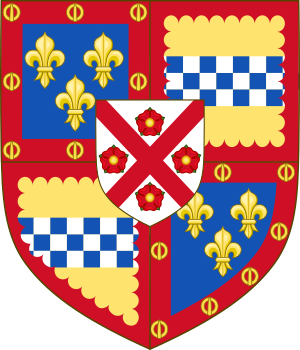Bernard Stewart, 3rd Lord of Aubigny facts for kids
Bernard Stewart (born around 1452, died June 15, 1508) was a brave French soldier and a clever diplomat. He was also known as Bérault Stuart in French. Bernard came from the Scottish family of Stewart of Darnley. He was a leader of the Garde Écossaise, which was the royal bodyguard of the French king.
Contents
Early Life and Royal Service
Bernard Stewart was the grandson of Sir John Stewart of Darnley. John Stewart received land in France, like Aubigny-sur-Nere, for his help during the Hundred Years' War. Just like his father and grandfather, Bernard was well-liked by the French King. He was chosen to lead the king's special bodyguard.
Because of his Scottish family background, Bernard was sent to Scotland. His job was to tell King James III of Scotland that Charles VIII of France was now the new French king. Bernard also had to sign a new treaty with Scotland. This treaty renewed the "Auld Alliance", a long-standing friendship between France and Scotland. He successfully signed this treaty on March 22, 1484.
Helping Henry Tudor Become King
Bernard Stewart also played a key role in English history. He was the main contact between the French king and some Scottish lords. These lords supported Henry Tudor, who wanted to become King of England. Henry Tudor was living in France as an exile at the time.
Henry Tudor and his supporters needed help from the French king. They needed money to pay for an army and soldiers to fight. In 1485, Bernard Stewart was chosen to lead the French troops. These troops went with Henry Tudor to England. They helped Henry win the Battle of Bosworth Field. This victory made Henry Tudor the new King Henry VII of England. It also started the Tudor Dynasty in England.
Adventures in the Italian Wars
In 1494, King Charles VIII of France claimed the Kingdom of Naples in Italy. Bernard Stewart was sent to Rome to talk to Pope Alexander VI about this claim. When the Pope did not agree, King Charles VIII gathered a large army. This army had 25,000 soldiers, including 8,000 Swiss mercenaries.
Bernard Stewart was ordered to lead one thousand of the king's cavalry (horse soldiers). They crossed the Alps mountains into Lombardy, Italy. He helped King Charles conquer an area called Romagna. Then, he marched with the king into Florence on November 15, 1494, celebrating their victory. After this, Bernard was made governor of Calabria and a top general of the French army.
Fighting in Naples
The French army quickly took control of many parts of Italy. They arrived in Naples on February 21, 1495. King Ferdinand II of Naples had already fled to Sicily. In Sicily, Ferdinand joined his cousin, Ferdinand II of Aragon, who was King of Spain and Sicily. They planned to get Naples back.
Other Italian states formed the League of Venice to stop the French. This league threatened to trap the French army in the south. On May 30, 1495, King Charles split his army. He took half his troops north to fight their way back to France. He left Bernard Stewart and the rest of the army to hold the conquered lands. After a tough fight at the Battle of Fornovo, Charles returned safely to France. Bernard Stewart and his men were left to face the Spanish invasion.
The Battle of Seminara
The Spanish general Gonzalo Fernández de Córdoba arrived in Sicily with an army. King Ferdinand of Naples had already crossed into Calabria and taken back Reggio. De Córdoba joined him two days later. He had about 600 Spanish cavalry and 1,500 infantry. Many more soldiers from the Spanish fleet and 6,000 local volunteers joined them.
Bernard Stewart became very sick with malaria. But he quickly gathered his forces to fight the Spanish and Neapolitan armies. He called in soldiers from other areas and asked for more Swiss mercenaries. In the following Battle of Seminara, Bernard's French cavalry and Swiss pikemen defeated the Spanish and Neapolitan armies.
Later Campaigns in Italy
Bernard Stewart also took part in King Louis XII of France's campaign in 1499. After this success, he became Governor of Milan. He commanded the French army left behind to protect northern Italy. In 1501, he finished conquering Naples and was made its Governor. However, after some victories in Calabria, he was completely defeated at the second Battle of Seminara (1503). He was captured and held prisoner at the Castel Nuovo in Naples. He was released after a peace agreement on November 11, 1503.
Later Life and Legacy
In 1508, Bernard Stewart was sent as an ambassador to Scotland. He met with King James IV of Scotland to discuss a marriage. This marriage was between Princess Claude of France and the future King Francis I of France. Because of this trip, a famous Scottish poet named William Dunbar wrote two poems about Bernard Stewart.
The French king made Bernard a member of the Order of St Michael, a very important award. Bernard Stewart died in Scotland around June 12, 1508, in a place called Corstorphine.
He is buried in the church at Corstorphine. People say his grave had a cross made of fine gold. This cross gave the area its name, "Cruce D'or Fin" in French. Bernard Stewart also wrote a book about military science called Traité sur l'art de la guerre. This book was reprinted in 1976.
Family and Titles
Bernard Stewart was married twice. His first wife was Guillemette de Boucard. His second wife was Anne de Maumont, who was the Countess of Beaumont-le-Roger. This marriage made him the Count of Beaumont-le-Roger. He also received many other titles in the Kingdom of Naples. These included Count of Arena, Marquis of Squillace, Marquis of Girace, and Duke of Terranuova.
Bernard Stewart had one child, a daughter named Anne. Anne married her first cousin, Robert Stewart, Lord of Aubigny. Robert later became a Marshal of France, a very high military rank.


